Transcription
From : ID: 16995321
To: GARY FIELDS, ID: M05398
Date: 10/6/2019 3:49:12 PM EST. Letter ID: 661795523
Location: 401
Housing: D2203L
Hello friends,
This is one of the reasons why I feel so blessed to be here at E.C.I.
Gary. Did you hear about this? It was online, will do some copy and paste and see if you get it Let me know if you get this?
Bootleg film shows Florida prison in all its danger, squalor. An inmate shot it on the sly
BY ROMY ELLENBOGEN
OCTOBER 04, 2019 02:27 PM, UPDATED OCTOBER 04, 2019 09:00 PM
Scott Whitney, an inmate at Martin Correctional Institution, captured footage over four years that shows rampant drug problems, violence, mold and crumbling conditions, offering a rare look at Florida's prison system BY JACK BROOK | ROMY ELLENBOGEN
Scott Whitney, inmate No. U21924, filmed a documentary on the Florida prison system and nobody knew.
At least the guards didn't.
Over a period of years, the convicted drug trafficker used specially rigged, almost cartoonishly oversize eyeglasses fitted with hidden cameras and a hollowed-out Bible with a lens peeking through the O in HOLY to capture the gritty. ugly, violent world inside Martin Correctional Institution, one of Florida's more notoriously dangerous prisons.
TOP ARTICLES
The video was smuggled out of the prison and given to the Miami Herald.
Whitney filmed men brawling or ready to swing locks at each other, inmates passed out on synthetic drugs, mold covering the walls of the kitchen like a coat of dark paint, easily accessible drugs smoked in plain view, makeshift knives traded for a few dollars' worth of food and other scenes from daily life in a Florida prison.
18675033_1580812575326121_2063701405_fitted(2).jpeg
Scott Whitney demonstrates the oversize eyeglasses that were fitted with a camera lens.
He also captured the scene during Hurricane Irma, when inmates evacuated to Martin slept on cots on the floor or on top of long, cafeteria-style tables.
To get a more realistic glimpse of life behind bars, you'd have to be convicted of a felony or be one of the officers along the wall.
The Florida Department of Corrections has gone to serious lengths, spending taxpayer money in court, to prevent the Miami Herald and other news organizations from accessing footage from prison surveillance cameras. It has claimed the release of those images would jeopardize security by revealing the layout of a compound and the location of cameras. The fact that a prisoner could record scores of hours of video — right under the noses of corrections officers and for four years — is astonishing.
Whitney calls the documentary "Behind Tha Barb Wire." He is the vice president of the endeavor, which drew up a contract and had inmates sign release waivers.
"We going live behind the barb wire, we risking our lives for this man," one inmate says in a snippet of footage. Although the corrections officers were seemingly oblivious to Whitney's film project, inmates were not. They speak openly to the camera.
bibl_fitted.jpeg
Scott Whitney concealed a camera inside his Bible. He used it to record life inside Martin Correctional Institution. The lens peeked through a hole inside the letter O in the word Holy.
Although Whitney had been filming since 2015, only clips from 2017 onward were successfully smuggled out. He gave the Miami Herald permission to post them online.
The Department of Corrections was asked multiple times to comment on this story but did not do so before online publication. After the article appeared on the Miami Herald's website, the department sent an unsigned statement, which read, in part: "The department is aware of the video and takes this information seriously. The FDC Office of Inspector General has an ongoing investigation into this video."
*The department uses every tool at their disposal to mitigate violence and contraband within our institutions," the FDC added.
The statement expressed dismay that the Herald did not share the video in advance. (It was blurring faces of inmates to protect the prisoners from possible retribution.) The Herald had informed the department that a snippet of raw video could be viewed on YouTube.
For a device that is considered contraband, there are a lot of cell phone cameras inside Florida prisons. According to the FDC, roughly 9,000 cellphones were recovered in the most recent 12-month period. The vast majority of the phones are coming in through corrections officers and other staff, who can make big daily profits by giving them to inmates, who sell access to others, said Ron McAndrew, a prison consultant and former warden.
However, he said footage shot by inmates and spirited out of the compound is extremely rare. He said the first real example of that was at Lake Correctional Institution in July, when a video from an inmate's phone posted to YouTube captured corrections officers beating an inmate. Four officers were arrested after it was posted.
Having a contraband phone in prison can result in a felony charge, according to state statutes.
"There is always the threat of prosecution," McAndrew said. "Being rearrested, having the state attorney drag you on the coals and add some years to your sentence."
shiv (1_fitted.jpeg
A prisoner at Martin Correctional Institution handles a homemade knife, one of the countless contraband items circulating in the prison.
The last time and only time a documentary was filmed in a Florida prison, at Santa Rosa Correctional Institution in 2012, was a disaster for the secretary who approved it. Filming of the MSNBC show "Lockup" irritated then-Gov. Rick Scott, who pulled the plug. Ed Buss lost his job. In other states, documentarians have been allowed inside prisons, but unfiltered, prisoner-produced video is extraordinarily rare. Earlier this year, photos from inside Alabama and Mississippi prisons were leaked, stirring calls for reform.
David Fathi, the director of the ACLU's National Prison Project, said as technology has developed, videos and photos from inside prisons have become more common.
"This would be, to my knowledge, the first prison documentary filmed exclusively by a prisoner with a cellphone," he said.
Fathi said the issue is paradoxical prisons have good reason for forbidding cellphones, but the footage also increases transparency, shining daylight in a dark place and potentially exposing abuses.
Whitney's videos show the widespread drug problems in the prison system. Men pass out on the floor or are taken away in stretchers after "twaking out." Some, their eyes half-lidded and vomit on their faces, are just guided back to their cell, where they ride out the high. One video shows a man face down in a pool of his own blood, the side of his cheek coated, as he coughs more of it up.
mold fitted.png
A coating of mold is evident in the kitchen at Martin Correctional Institution.
The main culprit is K2, also known as Spice or twak. K2 is a synthetic cannabinoid made with household items that is harder to detect than other drugs via urine test. It's the most frequent contraband drug confiscated by correctional officers and the leading cause of overdose deaths, according to a department audit.
"They just let you twak out all day long." Whitney says in one video. In another, he says "you know you might not wake up any day you smoke that."
wee_fitted.jpeg
Pot is plentiful inside Martin Correctional Institution, as demonstrated by this array.
When a video showing some of Whitney's footage was posted by Jordyn Gilley-Nixon, a former inmate and prison reform advocate, on YouTube on Sept. 19, Whitney was placed in confinement, a highly restricted form of incarceration, where he remains. She said she was inspired to post the footage, which was sent to her, in the aftermath of a beating at Lowell Correctional of a woman with disabilities. Cheryl Weimar was attacked so savagely by staff that she is said to be paralyzed from the neck down.
Gilley-Nixon said the footage points to the lack of care correctional officers have for inmates.
"The things that are going on would not be going on if staff was present at their job post the way DOC mandates," she said.
In one of the videos, Whitney films openly during count, without the help of his secret Bible. Instead of stopping to look into the room, a correctional officer quickly moves by without slowing.
"They don't give a damn," Whitney says about the officers in a whisper. "They don't look, they don't care if we're living, they don't check to see if we're safe.
vest (1_fitted.jpeg
Scott Whitney, Florida inmate and furtive filmmaker, shows off his makeshift stab-proof vest. Martin Cl had 31 deaths in the past six years, five of them homicides, according to department records. In some scenes, men show their scarred-over stab wounds. Whitney created a makeshift stab-proof vest, fashioned from mattress lining cut into a tank top, with pockets to hold a hardback book over his chest, because of the high number of attacks in the prison, which he calls "Murder Martin." He shows off the vest in one video scene.
"We finna show y'all some real s--, man, on how we live in here that y'all ain't seen," one inmate says to the camera after talking about a TV show scene of a prison. "We ain't playing this S---"
Along with the more gruesome videos showing drug use and violence, Whitney also captured inmates in their downtime freestyle rapping, gathering the rodents and snakes around the compound as pets or talking about where they're from and their cases.
The criminal behavior inmates show isn't unexpected, Gilley-Nixon said. But she said staff neglect prevents the inmates from getting the help they need to reform, and encourages recidivism. In Florida, about 25 percent of the inmates return to prison within three years of release.
Two inmates at Martin Correctional Institution settle a dispute with their fists.
"Inmates are going to be inmates," she said. You have some people who realize they've made a mistake and they do everything they can to change it. But you can't change it in that environment. It does not allow for reform, it does not allow for correction."
Whitney, 34, has been in prison since 2012 on a charge of conspiracy to traffic. His current release date is 2040, and he must serve a 25-year mandatory minimum for the drug trafficking charge.
During the filming. Whitney got his phone confiscated and did a 60-day stint in confinement. Still, once he got out, he almost immediately secured another camera and filmed another video.
Inmates from other prison facilities were imported to Martin Correctional Institution during 2017's Hurricane Irma. They slept on mats on the floor
"Money makes the world go round," he said. "And there's corruption everywhere in the system."
If and when he ever gets out of confinement this time, Whitney plans to keep filming
Whitney filmed men brawling or ready to swing locks at each other, inmates passed out on synthetic drugs, mold covering the walls of the kitchen like a coat of dark paint, easily accessible drugs smoked in plain view, makeshift knives traded for a few dollars' worth of food and other scenes from daily life in a Florida prison.
He also captured the scene during Hurricane Irma, when inmates evacuated to Martin slept on cots on the floor or on top of long, cafeteria-style tables.
To get a more realistic glimpse of life behind bars, you'd have to be convicted of a felony or be one of the officers along the wall.
The Florida Department of Corrections has gone to serious lengths, spending taxpayer money in court, to prevent the Miami Herald and other news organizations from accessing footage from prison surveillance cameras. It has claimed the release of those images would jeopardize security by revealing the layout of a compound and the location of cameras. The fact that a prisoner could record scores of hours of video - right under the noses of corrections officers and for four years — is astonishing.
Whitney calls the documentary "Behind Tha Barb Wire." He is the vice president of the endeavor, which drew up a contract and had inmates sign release waivers.
"We going live behind the barb wire, we risking our lives for this man,' one inmate says in a snippet of footage. Although the corrections officers were seemingly oblivious to Whitney's film project, inmates were not. They speak openly to the camera.
Scott Whitney concealed a camera inside his Bible. He used it to record life inside Martin Correctional Institution. The lens peeked through a hole inside the letter O in the word Holy. Although Whitney had been filming since 2015, only clips from 2017 onward were successfully smuggled out. He gave the Miami Herald permission to post them online.
The Department of Corrections was asked multiple times to comment on this story but did not do so before online publication. After the article appeared on the Miami Herald's website, the department sent an unsigned statement, which read, in part: "The department is aware of the video and takes this information seriously. The FDC Office of Inspector General has an ongoing investigation into this video."
"The department uses every tool at their disposal to mitigate violence and contraband within our institutions," the FDC added.
The statement expressed dismay that the Herald did not share the video in advance. (It was blurring faces of inmates to protect the prisoners from possible retribution.) The Herald had informed the department that a snippet of raw video could be viewed on YouTube.
For a device that is considered contraband, there are a lot of cell phone cameras inside Florida prisons. According to the FDC, roughly 9,000 cellphones were recovered in the most recent 12-month period. The vast majority of the phones are coming in through corrections officers and other staff, who can make big daily profits by giving them to inmates, who sell access to others, said Ron McAndrew, a prison consultant and former warden.
However, he said footage shot by inmates and spirited out of the compound is extremely rare. He said the first real example of that was at Lake Correctional Institution in July, when a video from an inmate's phone posted to YouTube captured corrections officers beating an inmate. Four officers were arrested after it was posted.
Having a contraband phone in prison can result in a felony charge, according to state statutes.
"There is always the threat of prosecution," McAndrew said. "Being rearrested, having the state attorney drag you on the coals and add some years to your sentence."
The last time and only time a documentary was filmed in a Florida prison, at Santa Rosa Correctional Institution in 2012, was a disaster for the secretary who approved it. Filming of the MSNBC show "Lockup" irritated then-Gov. Rick Scott, who pulled the plug. Ed Buss lost his job. In other states, documentarians have been allowed inside prisons, but unfiltered, prisoner-produced video is extraordinarily rare. Earlier this year, photos from inside Alabama and Mississippi prisons were leaked, stirring calls for reform.
David Fathi, the director of the ACLU's National Prison Project, said as technology has developed, videos and photos from inside prisons have become more common.
"This would be, to my knowledge, the first prison documentary filmed exclusively by a prisoner with a cellphone," he said.
Fathi said the issue is paradoxical — prisons have good reason for forbidding cellphones, but the footage also increases transparency, shining daylight in a dark place and potentially exposing abuses.
Whitney's videos show the widespread drug problems in the prison system. Men pass out on the floor or are taken away in stretchers after twaking out." Some, their eyes half-lidded and vomit on their faces, are just guided back to their cell, where they ride out the high. One video shows a man face down in a pool of his own blood, the side of his cheek coated, as he coughs more of it up.
The main culprit is K2. also known as Spice or twak. K2 is a synthetic cannabinoid made with household items that is harder to detect than other drugs via urine test. It's the most frequent contraband drug confiscated by correctional officers and the leading cause of overdose deaths, according to a department audit.
"They just let you twak out all day long." Whitney says in one video. In another, he says "you know you might not wake up any day you smoke that."
When a video showing some of Whitney's footage was posted by Jordyn Gilley-Nixon, a former inmate and prison reform advocate, on YouTube on Sept. 19, Whitney was placed in confinement, a highly restricted form of incarceration, where he remains. She said she was inspired to post the footage, which was sent to her, in the aftermath of a beating at Lowell Correctional of a woman with disabilities. Cheryl Weimar was attacked so savagely by staff that she is said to be paralyzed from the neck down.
Gilley-Nixon said the footage points to the lack of care correctional officers have for inmates.
"The things that are going on would not be going on if staff was present at their job post the way DOC mandates," she said.
In one of the videos, Whitney films openly during count, without the help of his secret Bible. Instead of stopping to look into the room, a correctional officer quickly moves by without slowing.
"They don't give a damn," Whitney says about the officers in a whisper. "They don't look, they don't care if we're living. they don't check to see if we're safe."
Scott Whitney, Florida inmate and furtive filmmaker, shows off his makeshift stab-proof vest. Martin Cl had 31 deaths in the past six years, five of them homicides, according to department records. In some scenes, men show their scarred-over stab wounds. Whitney created a makeshift stab-proof vest, fashioned from mattress lining cut into a tank top, with pockets to hold a hardback book over his chest, because of the high number of attacks in the prison, which he calls "Murder Martin." He shows off the vest in one video scene.
"We finna show y'all some real s--, man, on how we live in here that y'all ain't seen," one inmate says to the camera after talking about a TV show scene of a prison. "We ain't playing this s---"
Along with the more gruesome videos showing drug use and violence, Whitney also captured inmates in their downtime freestyle rapping, gathering the rodents and snakes around the compound as pets or talking about where they're from and their cases.
The criminal behavior inmates show isn't unexpected, Gilley-Nixon said. But she said staff neglect prevents the inmates from getting the help they need to reform, and encourages recidivism. In Florida, about 25 percent of the inmates return to prison within three years of release.
"Inmates are going to be inmates," she said. "You have some people who realize they've made a mistake and they do everything they can to change it. But you can't change it in that environment. It does not allow for reform, it does not allow for correction."
Whitney. 34, has been in prison since 2012 on a charge of conspiracy to traffic. His current release date is 2040, and he must serve a 25-year mandatory minimum for the drug trafficking charge.
During the filming, Whitney got his phone confiscated and did a 60-day stint in confinement. Still, once he got out, he almost immediately secured another camera and filmed another video
Inmates from other prison facilities were imported to Martin Correctional Institution during 2017's Hurricane Irma. They slept on mats on the floor.
"Money makes the world go round," he said. "And there's corruption everywhere in the system."
If and when he ever gets out of confinement this time, Whitney plans to keep filming.
Gary Field
DC#M05398
Everglades C.I.
1599 SW 187 Ave.
Miami, Fl.
33194
Other posts by this author
|
2021 jul 3

|
2021 mar 7

|
2021 mar 3

|
2021 jan 31
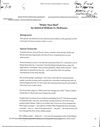
|
2020 nov 19
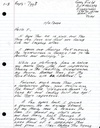
|
2020 oct 29

|
More... |

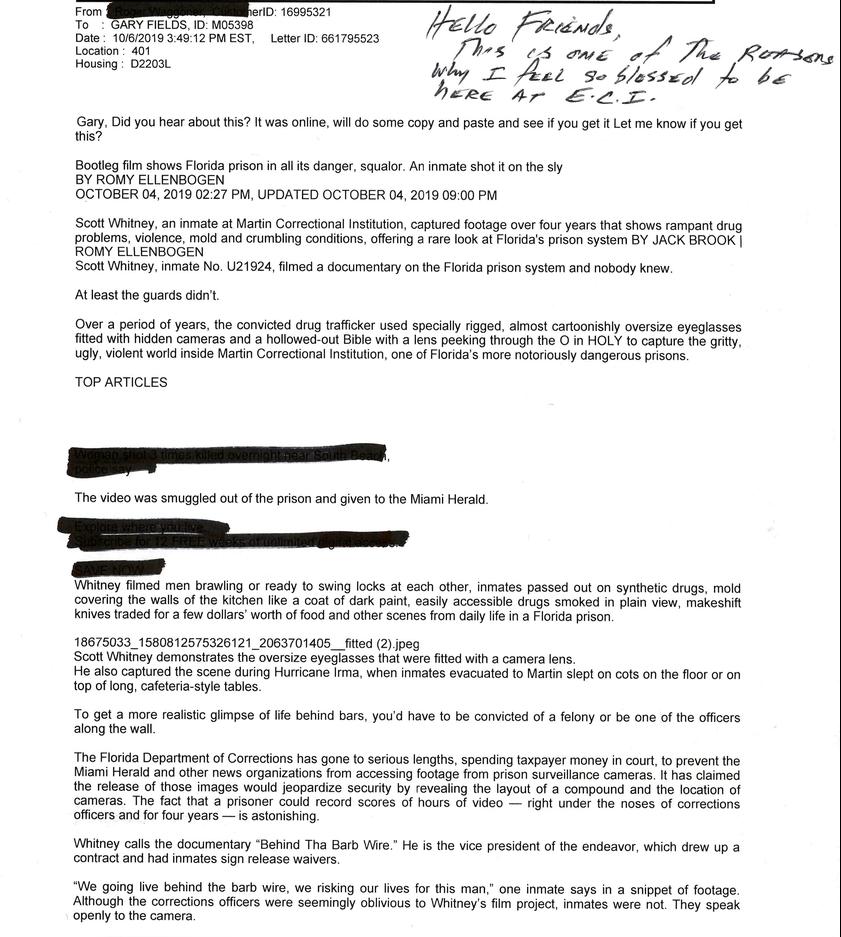
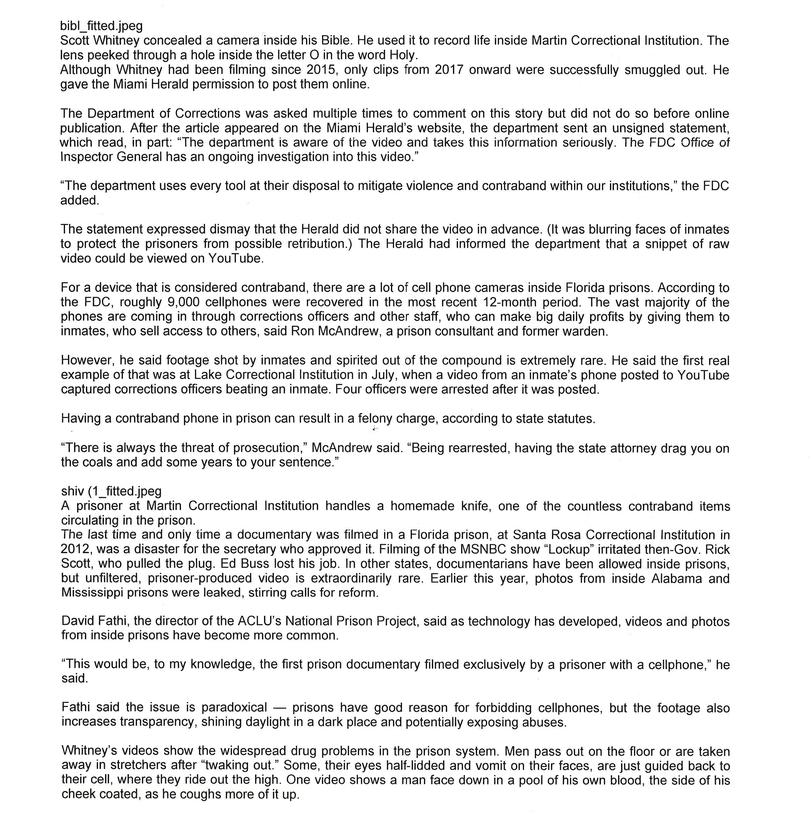
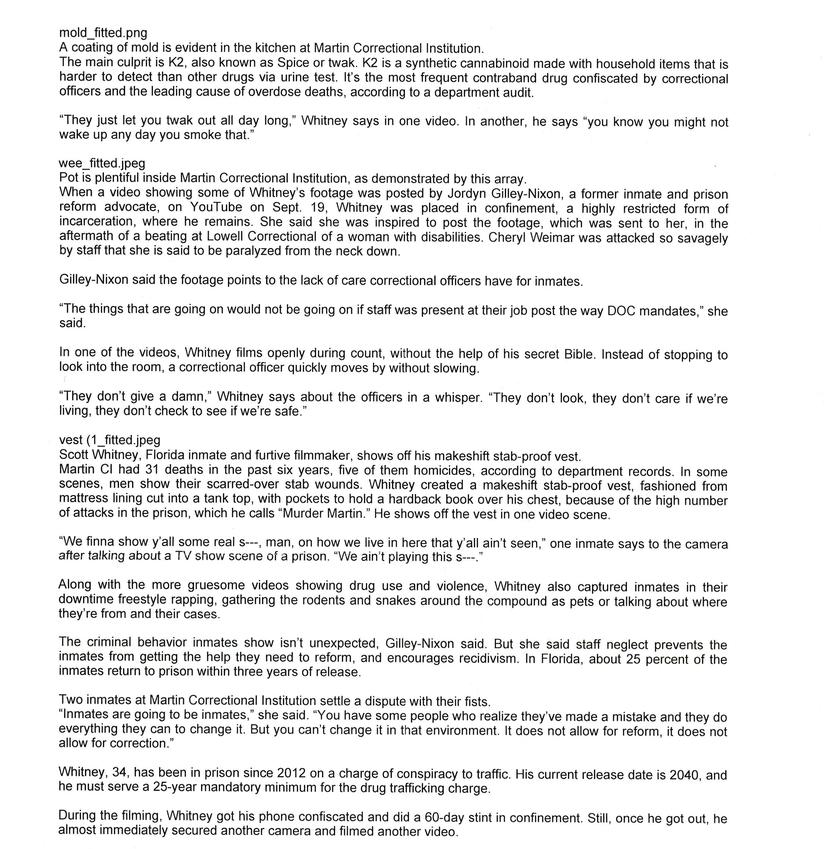
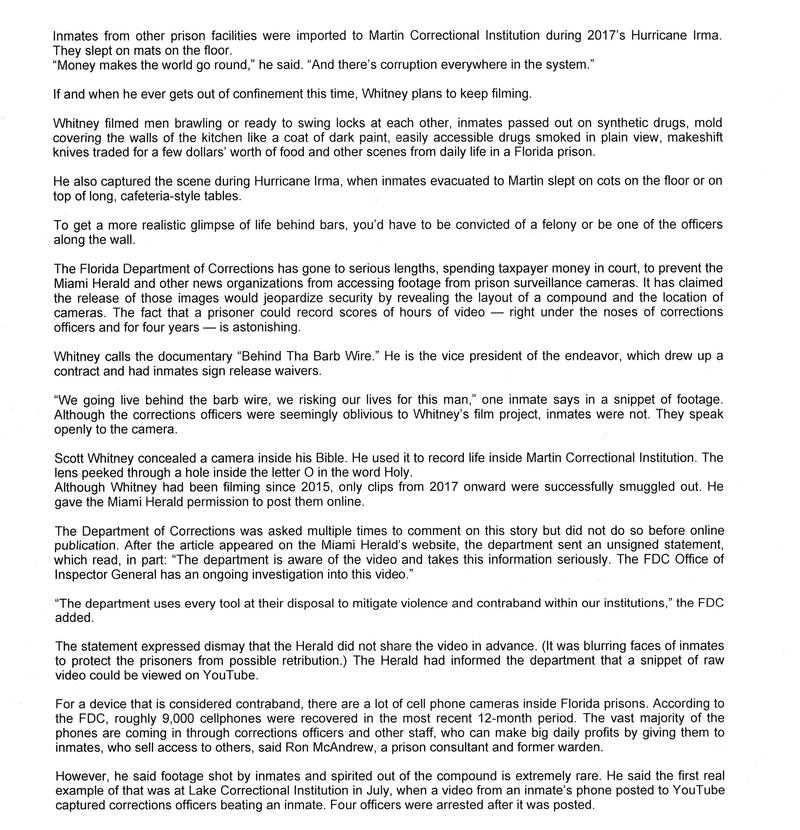
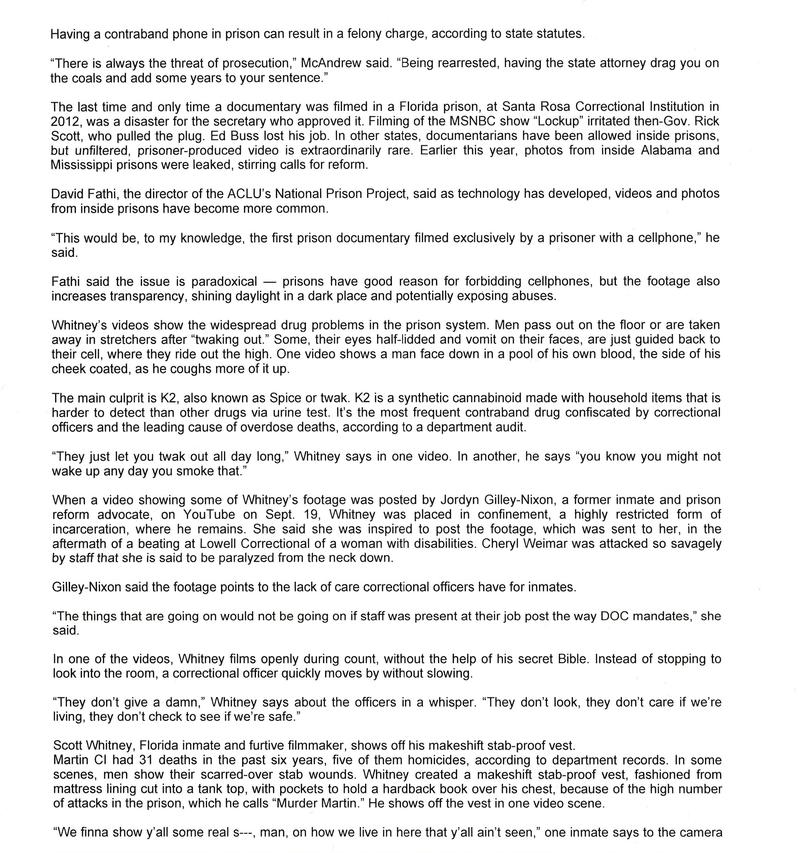
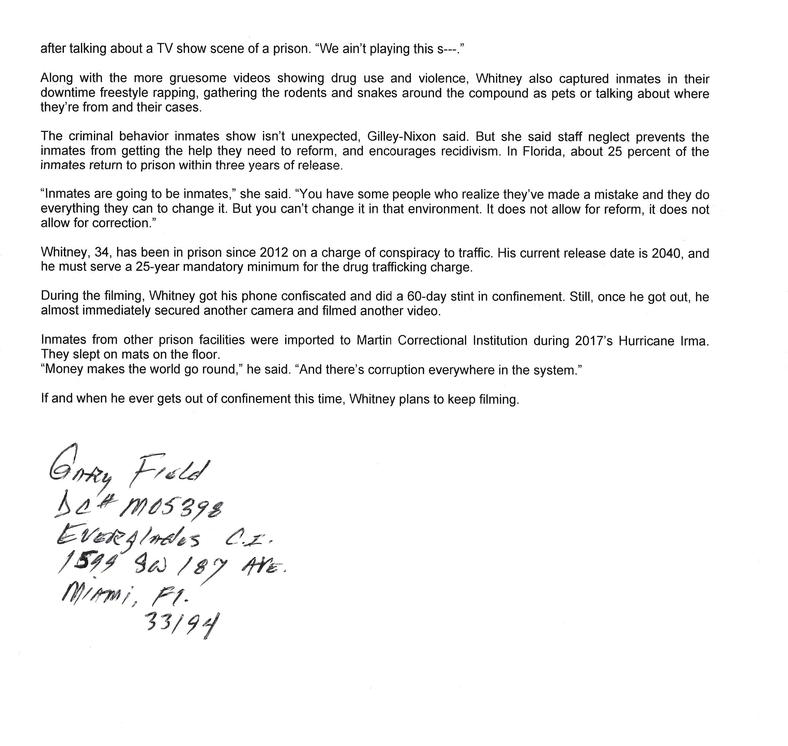

Replies